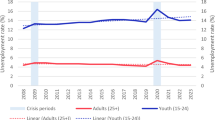Abstract
Job offers requiring varying commuting times to work from inner-city areas and the reservation wages for a sample of young Chicano job seekers are examined. A logistic probability model of job acceptance using the minimum wage as an acceptance-rejection cutoff in relation to the reservation wage data is estimated by maximum likelihood techniques and suggests that the level of schooling is an important determinant of the probability of job acceptance. The results of this analysis suggest a restriction on the geographic range of job acceptances to the extent that minimum wage job offers located away from inner city, minority neighborhoods would most likely be rejected by the sample of minority youth job seekers.
Similar content being viewed by others
References
Kim B. Clark and Lawrence H. Summers, “The Dynamics of Youth Unemployment,” in Freeman and Wise (eds.) (1982), 199–230.
Richard B. Freeman and David A. Wise(eds.),The Youth Labor Market Problem: Its Nature, Causes, and Consequences (Chicago; University of Chicago Press, 1982).
Sheldon Danziger and Michael Weinstein, “Employment Location and Wage Rates of Poverty-Area Residents,”Journal of Urbvan Economics, vol. 3 (April, 1976), 127–145.
John F. Kain and John Meyer, “Transportation and Poverty,”Public Interest, vol. 18 (Winter, 1970), 74–87.
John F. Kain, “Housing Segregation, Negro Employment and Metropolitan Decentralization,”Quarterly Journal of Economics, vol. 82 (May, 1968), 1–23.
Nicholas M. Kiefer and George R. Neumann, “An Empirical Job-Search Model, with a Test of the Constant Reservation-Wage Hypothesis,”Journal of Political Economy, vol. 87 (January, 1979), 89–107.
Garth L. Mangum and Stephen F. Seninger,Coming of Age in the Ghetto: A Dilemma of Youth Unemployment (Baltimore: Johns Hopkins University Press, 1978).
Lawrence C. Morse, “Increasing Unemployment and Changing Market Expectations Among Black Male Teenagers,”American Economic Review, vol. 71, no. 2 (May, 1981), 374–378.
Stephen F. Seninger and Garth L. Mangum,Central City Employment Opportunity Study, report to the U.S. Department of Labor and Community Services Administration, Washington, D.C., September, 1981.
Stanley P. Stephenson, “The Economics of Youth Job Search Behavior,”Review of Economics and Statistics, vol. 58 (February, 1976), 104–111.
Robert Sugden, “An Application of Search Theory to the Analysis of Regional Labor Markets,”Regional Science and Urban Economics, vol. 10, no. 1 (March, 1980), 43–51.
Author information
Authors and Affiliations
Additional information
The author thanks Frank Lad and John Vrooman for helpful comments, Kevin Higgins and Ahmad Vedadi for computer programming assistance and the referee for helpful comments. The research reported here was supported in part by the Community Services Administration and the Office of Youth Programs and a Summer Research Grant from the University of Utah Center for Policy Analysis; the findings and conclusions represent the views of the author.
Rights and permissions
About this article
Cite this article
Seninger, S.F. Worker mobility and reservation wages for minority youth job seekers. Ann Reg Sci 18, 62–68 (1984). https://doi.org/10.1007/BF01287376
Received:
Revised:
Issue Date:
DOI: https://doi.org/10.1007/BF01287376




